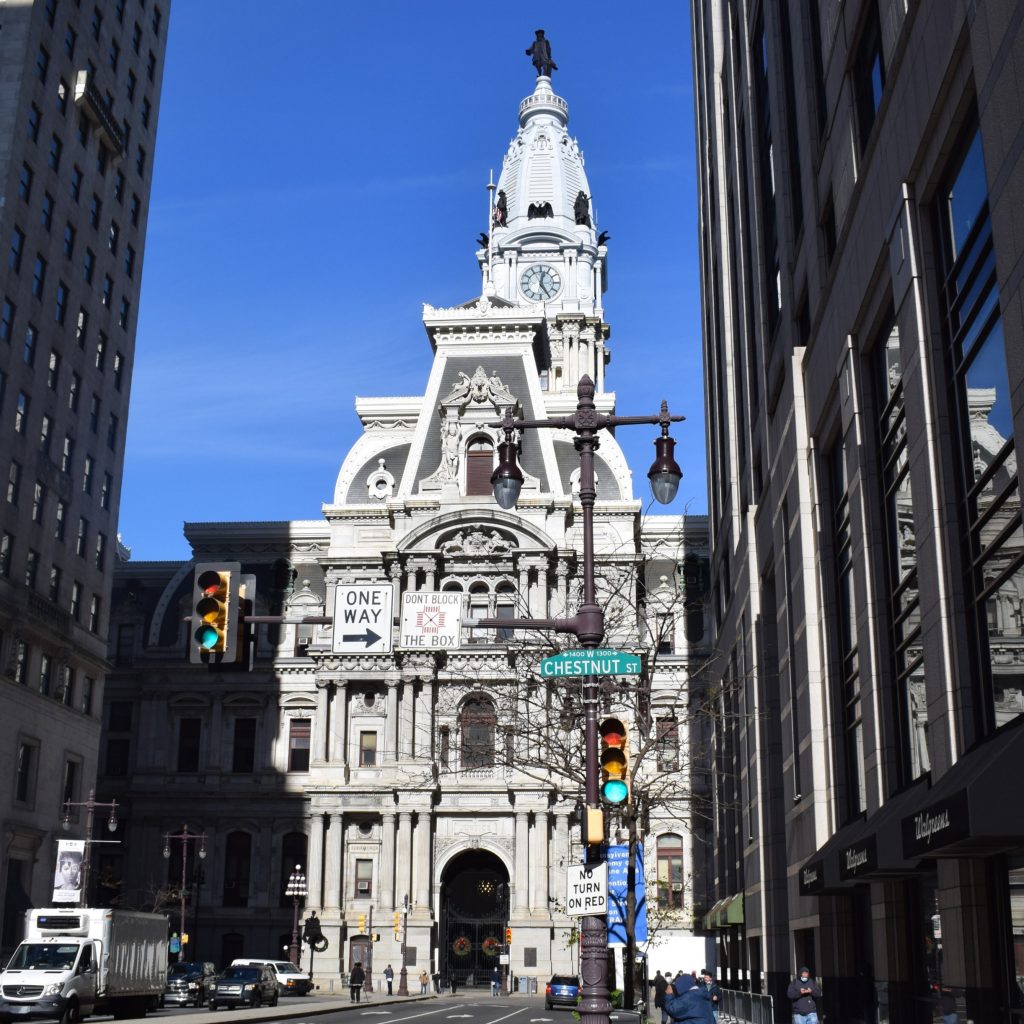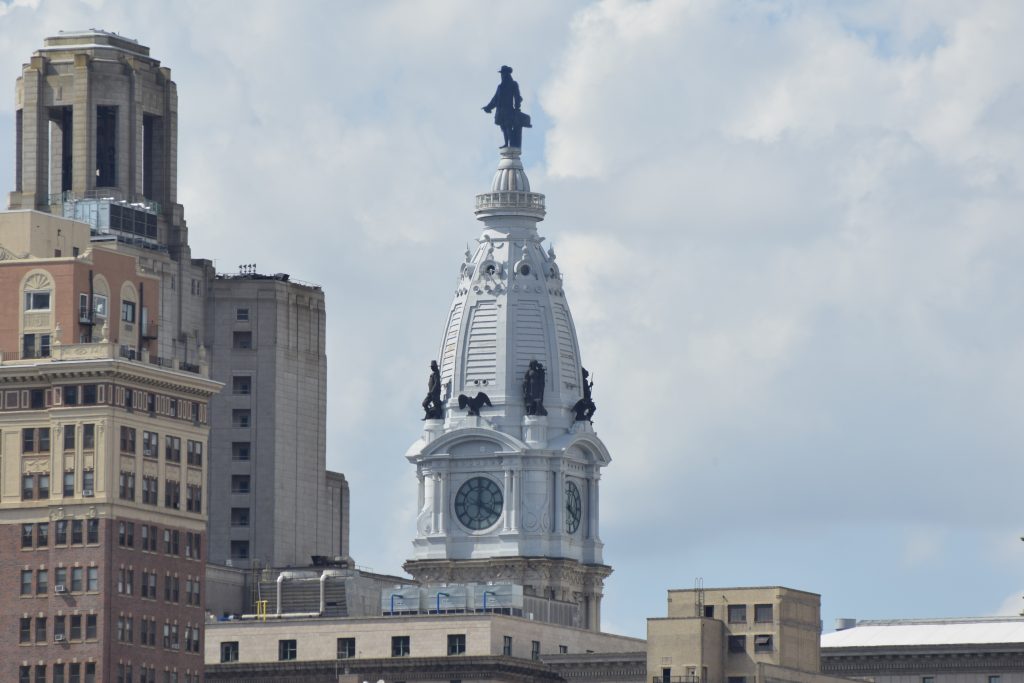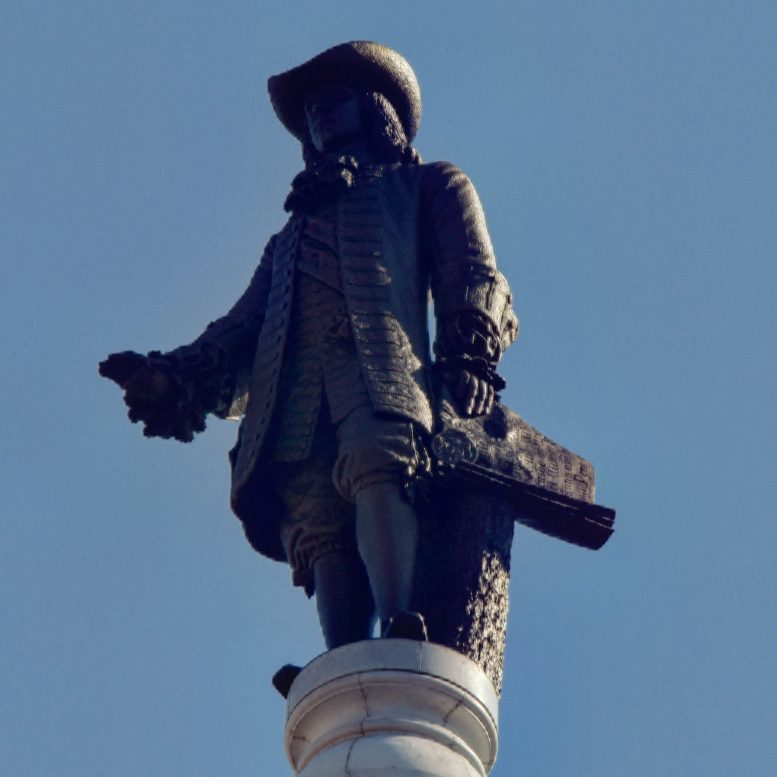The statue of William Penn has stood at the very top of Philadelphia City Hall in Center City for well over a hundred years, facing northeast. The large figure of the Quaker was crafted by sculptor Alexander Milne Calder, who also produced the smaller statues just above the clock house and around the entire building. The 548-foot-tall Philadelphia City Hall was designed by John McArthur Jr. and Thomas Ustick Walter, renown architects of their time. In this feature, Philadelphia YIMBY takes a look back at the original southern direction the statue was supposed to face and at the subsequent change.

Philadelphia City Hall from Broad Street. Photo and edit by Thomas Koloski
The design of the tower was finalized in the 1880s, nearly after 10 years of construction on the lower office floors. In 1886, the statue of William Penn was assembled, and then taken apart in 47 pieces. The statue was transported to the courtyard of City Hall in 1893, where it was put together and sat on display for citizens to gaze upon. The public was waiting to see William Penn lifted to the top of the tower, where he was supposed to face south and be drenched in sunlight all day.

Philadelphia City Hall from a nearby garage. Photo and edit by Thomas Koloski
On Thanksgiving Day in 1894, the head of the statue was fastened to the structure and the public immediately noticed that the sculpture was face the “wrong way,” which a large number of people found to disrespectful. The work was done without the approval of the Building Commission, and Alexander Milne Calder was also not a fan of the change. The statue faces Penn Treaty Park on the Delaware River waterfront, where William Penn first settled and signed treaties for peace. But, in old newspaper clippings from the time, the media states that the work was also done for architectural reasons.
Subscribe to YIMBY’s daily e-mail
Follow YIMBYgram for real-time photo updates
Like YIMBY on Facebook
Follow YIMBY’s Twitter for the latest in YIMBYnews


Philadelphia City Hall was finished 120 years ago in 1901.
The statue of William Penn was hoisted in position in 1894, making it the tallest statue on top of any building in the world.
The statue faces the Northeast towards Penns Treaty Park which commemorates the site where Penn signed a treaty with the local native American tribe.
The terms of the gentleman‘s agreement forbade all buildings to be built taller than the statue of the brim of the hat of William Penn atop of Philadelphia City Hall until One Liberty Place had surpassed it in 1986.
Since then, the Philadelphia skyline was transformed significantly with much taller buildings along with interesting nighttime lighting that helped make Philadelphia a desirable destination.
At 548 feet tall, including the statue of city founder William Penn, Philadelphia City Hall was the tallest habitable building in the world from 1894 to 1908.
The construction spanned 30 years from 1871 (150 years ago) to 1901 (120 years ago) and features 700 rooms of government offices.
The clock tower is 26 feet in diameter on each of the four sides and built in 1898. There are four bronze eagles featuring 12 foot wingspans, secured atop each of the four clocks.
I grew up in Philly but never heard of going up top to look around. I would have loved that
Brian. One Liberty was not the first building built higher than Billy Penn’s hat… Commerce Square one, 21st and Markey, was the first… I worked on that job
While Liberty One opened before Commerce Square, The steel at Commerce was the first to go higher than Billy Penn’s hat. Construction was delayed at Liberty because the welds failed inspection due to inferior imported steele. The towers were suppose to go much higher and the steele is much larger.But due to the inferior steel, it wasn’t considered safe by the engineers The second Liberty tower had a slip formed concrete core supporting the steel surrounding it.
I couldn’t exactly find it, but it doesn’t explain how it was hoisted.
I worked on Bill penn restoration 1988 With the ironworkers as a union painter I was told by historians that there was a ramp from arch Street up to the base of Billy Penn pulled up there with donkeys spent two seasons, working on that project very cold got my picture taken on top of his hat as we were setting up a Bozeman chair From his hat to touch up below the base of Billy Penn Picture taken by photographer from the inquiry building, which is now police headquarters Unbelievable picture that I still have